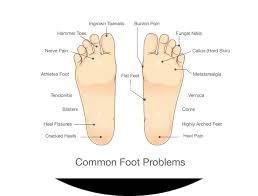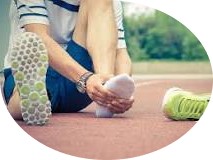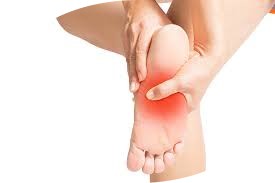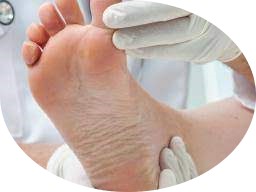
Health First Group strives to relieve you from physiological problems by not only providing the best physio therapy, but also through sharing valuable insight into the problem. Please read on to learn about the different types of foot complaints
Heel Pain
The most common of all foot complaints, an estimated 400,000 people in Australia suffer from it (Pain at the back of the heel pain is called Achilles Tendonitis or Bursitis. Young children may suffer from paediatric heel pain or Sever’s Disease).
Causes of Heel Pain
The medical condition named Plantar Fasciitis means “inflammation of Plantar Fascia”. Plantar Fascia is the tissue connecting your heel bone to your toes along the base of the foot. While a healthy Plantar Fascia should be strong and flexible, this is not always the case. Furthermore, old age, excessive body weight and incorrect foot function can stress the Plantar Fascia too much. This undue tension causes inflammation of the Plantar Fascia.
This constant tension leads to micro-tearing of the tissue and inflammation at the attachment of the plantar fascia and heel bone. Hence, the stabbing pain with your first steps in the morning or after sitting for a while.
Over-stretching of the Plantar Fascia is more likely to happen if:
- You suffer from over-pronation (lowering of the arch when the foot lands)
- You stand/walk on hard surfaces for long periods (because of your job)
- You have put on some weight in recent months/years or you are pregnant
- The muscles and tendons in your feet and legs are tight
- You are over 45
Summary:
Definition: Heel Pain (Latin: Plantar Fasciitis)
Symptoms: Sharp pain in the heel with first steps in the morning or after resting, subsiding to dull ache
Causes: Inflammation of the Plantar Fascia as a result of over-pronation
Treatment: Orthotic insoles to correct pronation; special exercises; rest/reduced activity
Causes of Heel Spurs?
Due to the continuous pulling of the fascia at the heel bone, the body eventually responds by developing a bony growth on the heel bone. This is called a Heel Spur or Calcaneal Spur. During rest (for example when you’re asleep), the Plantar Fascia tightens and shortens. When body weight is rapidly applied to the foot, the Fascia must stretch and quickly lengthen, causing irritation and tearing of the fascia. Hence, the sharp pain with your first steps in the morning.
Heel spurs are more likely to happen if:
- You suffer from over-pronation (flattening of the arch)
- You stand or walk on hard surfaces, for long periods
- You are overweight or pregnant
- You have tight calf muscles
Summary:
Definition: Heel Spur (Calcaneal spur)
Symptoms: Sharp pain in the heel with first steps in the morning or after resting, subsiding to dull ache
Causes: Inflammation of the Plantar Fascia as a result of over-pronation
Treatment: Orthotic insoles to correct pronation; special exercises; rest/reduced activity
Plantar Fasciitis
Plantar Fasciitis (also named “Policeman’s Heel”) is a painful inflammatory condition that causes chronic heel pain. In some cases it may also result in arch pain.
Symptoms of Plantar Fasciitis
The pain usually is felt on the heel’s underside. You feel the most pain when taking the first steps of the day. The sharp stabbing pain at the bottom or front of the heel bone turns into a dull ache as the day goes on.
Causes of Plantar Fasciitis
Mainly caused by abnormal pronation of the foot, Plantar Fasciitis is brought upon by factors such as age, weight gain, excessive walking or standing on hard surfaces, using worn out shoes with little support, as well as inactivity.
Summary:
Definition: Plantar Fasciitis = inflammation of the Plantar Fascia
Symptoms: Sharp pain in the heel with first steps in the morning or after resting, subsiding to dull ache
Causes: Poor foot biomechanics (over-pronation); age, weight gain
Treatment: Orthotic insoles to correct pronation; exercises; ice; rest or reduced activity
Arch Pain
Arch pain is also quite a common foot pain. Symptoms include pain in the arch in the morning when you get up after sleeping, as well as after long walks or prolonged standing.

Causes of Arch Pain
The most common cause of arch pain is Plantar Fasciitis. During your sleep, the ligaments under your foot contract and tighten up. So, when you get up in the morning, the tight Fascia is irritated as you stretch it by walking. A person suffering from arch pain usually has inflammation of the tissues within the mid-foot. Repeated strain can cause tiny tears in the ligament, causing inflammation, irritation, pain and swelling.
Arch Pain is more likely to happen if:
- Your feet roll inward too much (over-pronation)
- You walk, stand, or run for long periods of time, especially on hard surfaces
- You are overweight or pregnant
- You have tight Achilles tendons and/or calf muscles
Ankle Pain
A common foot complaint, ankle pain is usually of two types:
- Acute ankle pain
- Chronic ankle pain.
Acute Ankle Pain
Acute ankle pain is caused by trauma or injury. Ankle sprains, the most common ankle injury, usually occur in sports, running or athletics. Despite being very painful, ankle sprains can be healed within a few weeks simply by resting the foot.
Chronic Ankle Pain
Chronic ankle pain is a long-term foot complaint. The pain can be on the inside (medial ankle pain) or outside (lateral ankle pain) of the ankle. Stressed ankle tendons and nerves cause Medial ankle pain. Lateral ankle pain occurs due to compression of the soft tissue (tendons and ligaments) in the outer ankle area. Poor foot mechanics can also cause lateral ankle pain.
Summary:
Definition: ankle pain is either acute or chronic
Symptoms: permanent pain on the inside or outside of the ankle
Causes: abnormal foot mechanics i.e. excessive pronation
Treatment: orthotics, to correct over-pronation)
Achilles Tendonitis
Achilles Tendonitis is Latin for ‘inflammation of the Achilles Tendon’. The longest tendon in the body, the Achilles Tendon connects the calf muscles to the heel bone behind the ankle joint. The pain of Achilles Tendonitis, as well as a tightness in the calf muscles, is experienced above the back of the heel. You might notice that here the Achilles Tendon has thickened and is tender to the touch. Pain is felt during walking, especially when pushing off on the toes.
Causes of Achilles Tendonitis
Achilles Tendonitis is caused by a constant strain on the Achilles tendons, which may even rupture the tendon. Excessive overuse (like done by runners) can also bring about the condition, and so can tight calf muscles. Simple ageing also degenerates our tendons, weakening the tendon fibres. The most common cause is over-pronation, where the calf muscles are put under duress as the lower leg is forced to rotate internally due to excessive inward rolling of the feet
Summary:
Definition: Achilles Tendonitis = inflammation of the Achilles tendon
Symptoms: Pain and swelling at the back of heel
Causes: Over-use, tight calf muscles, over-pronation
Treatment: Stretching exercises and orthotics (to correct over-pronation)
Over-Pronation (Fallen Arches)
As a very common problem, over–pronation affects millions of Australians. It is estimated that over-pronation affects over 70% of the Australian population. Fallen Arches contribute to a range of common complaints including:
- Sore, aching feet
- Ball of Foot Pain
- Heel Pain
- Achilles Tendonitis
- Callous & corns
- Bunions
- Shin Pain
- Tired, aching legs
- Knee Pain
- Lower Back Pain
To understand over–pronation better, we will look into the 3 most common foot types.
- Flat Feet – Pes Planus (5% of the population)
- High Arched Foot – Pes Cavus (5% of the population)
- Pronating Foot – Fallen arches (70% of the population)

Flat Feet – Pes Planus
There are no arches in flat feet. The foot’s underside lies completely flat on the ground. True ‘flat foot’ is very rare occurring in less than 5% of the population. Flat feet are quite normal in small children as the arch starts to develop as they grow older. If you don’t see your child’s arch by age 5 – 6, there may be need for children’s orthotics.
High Arched Foot – Pes Cavus
Pes Cavus is the opposite of flat feet. It is a rare foot type where the arch is distinctly high when bearing weight.
Pronating Foot – Fallen arches
Most people have a low arch. As such, a ‘normal’ foot actually has a low but clear arch under the foot, especially when sitting down. Weight bearing determines arch behaviour. The arch lowers as we get up. When we walk the arch collapses – called “over-pronation” or “fallen arches”. Contrary to popular belief, over-pronation is different than flat feet. As pronation is necessary for our gait, it is not wrong in itself. However, by pronating too long and deep (over-pronating) we keep our feet from ‘recovering’.
This is injurious and must be avoided as over-pronation badly affects our natural walking pattern as well as affecting other parts of the body, one step at a time, literally.
Old age and poor feet alignment also contribute to knee and heel pain.
Causes of Over-Pronation
- Obesity
- Pregnancy
- Ageing
- Repetitive pounding on hard surface
Treatment
Over-pronation is a common problem in athletes (esp. runners. The orthotic shoe insert is the most effective treatment for over-pronation.
Combining the use of orthotic shoe inserts with some stretching exercises can treat over-pronation (as well as treating heel pain). Health First Group orthotics correct over-pronation, thereby providing natural, lasting pain relief to many aches and pains. Our orthotics reduce the tension on the Plantar Fascia, efficiently relieving your pain.
Ball of Foot Pain (Metatarsalgia)
Women who wear high heels often complain of pain under the ball of the foot. The pain can also present itself with flat shoes.
Symptoms
A burning sensation in the ball of the foot is a common symptom of Metatarsalgia. This feeling is often combined with excess callous forming. The longer you wear high heels, the more intense the pain becomes.
Causes of Ball of Foot Pain
The dropping of forefoot bones and weakening of surrounding ligaments usually cause Metatarsalgia. This is because the forefoot region is subject to the excessive pressure – 70-80% of your body weight.
Morton’s Neuroma
A neuroma is kind of a benign tumour of a nerve as it is basically a swelled or thickened tissue around the digital nerve that leads to the toes.
Similar to Metatarsalgia, Morton’s Neuroma has the additional effects such as tingling toes and numbness. Morton’s Neuroma occurs when the nerve between the 3rd and 4th metatarsal bones is squeezed and can be very painful in some instances.
Shin Splints (Shin Pain)
A painful shin is generally termed ‘Shin Splints’, with the pain occurring in the front or inside section of the shin bone.
Symptoms
The main symptom is shin tightening and tenderness, usually associated with some activity such as running and walking over long distances, especially if you have recently taken up these activities. Resting usually settles the pain.
Causes of Shin Splints
Excessive shin (tibia and fibula) muscles and tendons stretching is the usual suspect for causing shin splits. Over stretching by runners is very common.
Over-pronation is also a major cause of shin splits which leads to internal tibial rotation. This puts more pressure over the lower leg muscles and ligaments.
Tired, aching legs
Tired and/or aching legs are extremely common, especially in women and elderly people.
Symptoms
Tired and aching legs are usually felt by people in the back of their lower legs, in the calf muscles or behind the knee as a constant dull ache.
Causes of Aching Legs
Standing for too long is a common reason of aching legs. When this happens, the circulation becomes feeble in the leg arteries. Straining and over-stretching the calf muscles also causes tired and aching legs.
Standing for extended time periods and wearing high heels can cause and worsen this condition.
Exercising without proper stretching is another cause of tired/aching legs.

Treatment/Prevention
A simple rule – Don’t stand if you can sit and don’t sit if you can lay down.
If you are exercising, be sure that you do proper stretching prior to starting your work out. Stretching is a great way to enhance your flexibility. You should also perform stretching after working out as this enhances your blood flow.
Knee Pain (Patello-femoral syndrome a.k.a. runner’s knee)
Knee pain is very common. The different types of knee pain are:
- Patello-femoral Syndrome or Chondromalacia Patellae (most common).
- Sinding-Larson-Johansson Disorder
- Patella Tendinitis
- Bursitis
- Osgood-Schlatter (more common)
Symptoms of Patello-femoral Syndrome
A sharp pain in the knee and a grinding sensation, especially when getting up or walking up stairs.
The most common chronic knee pain Patello-femoral Syndrome is experienced with a pain that is felt between the knee cap (patella) and the underlying thigh bone (femur). It causes pain and tenderness in the front of the knee. It is also known as Anterior Knee Pain.
Not that pain occurring behind the knee is extremely rare. Patello-femoral pain is worse when you sit for long periods and get up out of a chair or the car, or when climbing stairs. Often, people experience a grinding or crunching sensation in the knee joint.
Knee pain usually results in a loss of mobility, with varying degrees of the loss depending on the nature of the cause of the pain.
Causes of Knee Pain
Trauma, injury and accidents can cause knee pain. The most common cause is simple wear and tear occurring in your daily life. The natural ageing process softens and wears out the cartilage behind the knee cap (patella) which causes small soft tissue areas to break down and tear.
Partial or even complete knee cartilage erosion is caused by constant grinding which also results in swelling and pain.
Years of playing soccer, rugby , cycling, running, as well as laborious occupations such as construction work, can take their toll on your knees through knee cartilage erosion resulting in knee pain.
Muscle imbalance (also called patella tracking disorder) is another reason of knee pain in which case the inner quadriceps become weaker than the outer quadriceps. The knee cap is pulled to a side by the stronger outer muscles which causes patella mal-tracking, resulting in knee pain.
Through specific exercises that strengthen the weak muscles, you can treat this disorder.
Foot biomechanics is yet another cause of knee pain caused by Patello-femoral syndrome. The way you place your ankles and feet play a great role in the health of your knees, legs, hips, and the lower back.
Knees are not designed to rotate like hip joints and ankles. So when rotation is forced on the lower leg because of over-pronation, the knee is subjected to unnatural stress. This type of wear and tear not only causes chronic knee pain but can also lead to long-term damage.
Due to the vast effects of over-pronation, feet assessment is now a part of knee pain diagnosis by most Australian physiotherapists.
Summary:
Definition: Knee Pain (Patello-femoral syndrome)
Symptoms: Sharp pain and grinding sensation
Causes: Wear & tear, age, faulty foot biomechanics (over-pronation)
Treatment: Orthotic insoles to correct foot pronation; knee braces; exercises, physiotherapy
Lower Back Pain (lumbo-sacral pain)
Back pain is an extremely common complaint with millions of Australians suffering. While most of these millions simply put up with back pain, they don’t have to.
Symptoms
Lower back pain is usually characterized by a dull aching sensation in the lower back accompanied by a feeling of tiredness, especially after standing for a while.
Causes of Lower Back Pain
Of all the various causes of lower back pain, the biggest culprit is simply poor body posture.
Whether you are working on a computer or tuned in to the television, you are usually in a very bad posture. It is an extremely common scenario not only in Australia but throughout the world. Even when people are not sitting, they have bad posture while they are standing. The problem is that most people are not even aware of their bad posture, hence the ‘abundance’ of lower back pain.
It is interesting to note that bad posture owes a lot to feet problem! Over-pronation throws the whole human body out of balance. In that case, the lower back pain is caused by constant tension put on the lower back muscles due to the increased spinal curvature.
If you are suffering from lower back pain, especially after you stand for extended time periods, you should give a thought to the fact that your feet might be the problem.
Summary:
Definition: Low Back Pain (lumbo-sacral pain)
Symptoms: Dull ache, tension in the lower back muscles, especially after standing
Causes: Poor body posture
Treatment: Orthotic insoles to correct foot pronation and improve body posture; exercises
Dealing with Foot Complaints
Information is only helpful if it is used properly. We have included the above information as a means of increasing your awareness regarding common (and some not so common) foot complaints. Health First Group is committed to finding the best solutions to all such complaints and improving your health. If you find yourself (or someone you care about) making any of the above complains, we are here to help.
Find your nearest clinic
With 18 clinics nationwide and many more on the way, there's bound to be one near you
Discover our locations